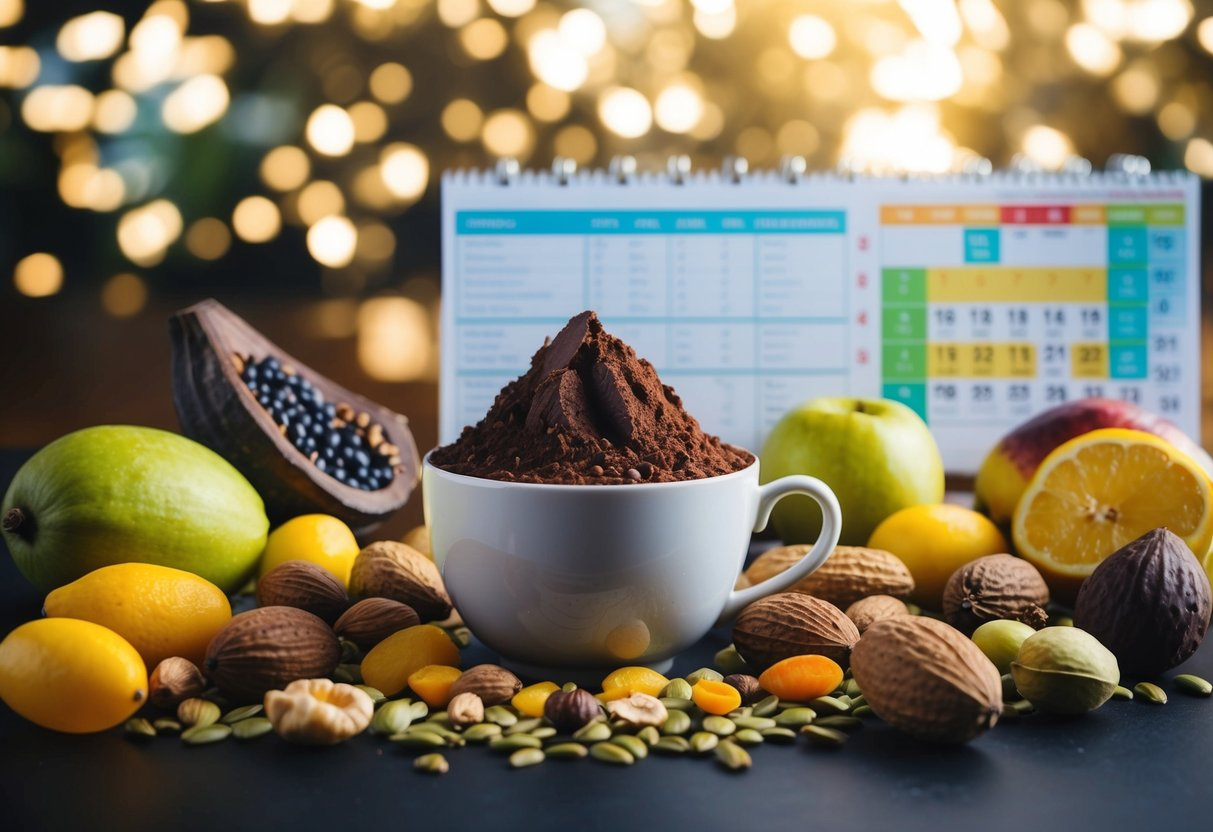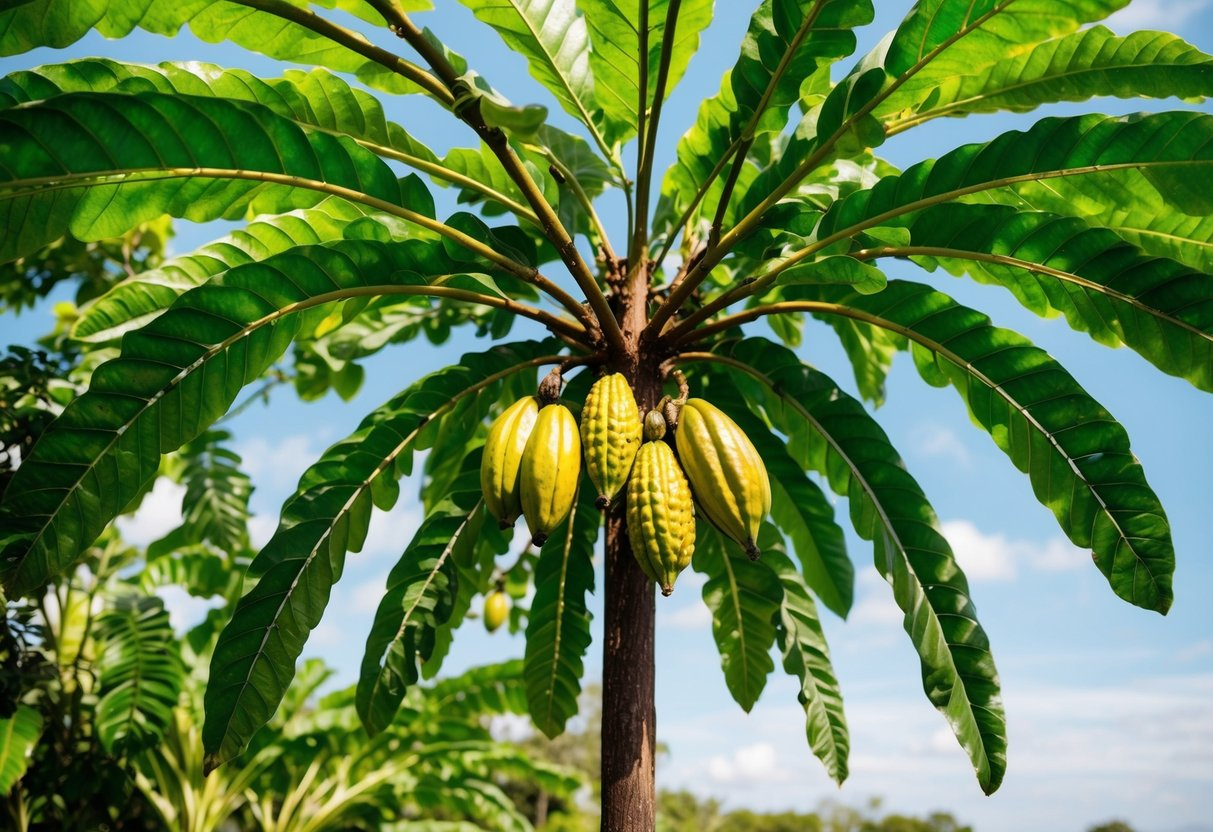Drinking cacao every day can have both positive and negative effects on your health. Whether it’s the deep, earthy taste or the whispers of potential health perks, folks just can’t get enough of this centuries-old superfood. Add a square of dark chocolate or a spoonful of cacao powder to your daily routine and you may be rewarded with a stronger heart, a sunnier disposition, and cells shielded from oxidative stress – a trio of benefits that’s hard to beat.

Cacao is packed with Blood pressure reduction is within reach thanks to natural compounds hiding in plain sight. Healthy blood flow gets a serious upgrade with this benefit. Depression can bene Fit from a boost of iron, and this pick-me-up is a potent natural source. Some studies suggest daily dark chocolate intake could enhance cognitive function .
But cacao isn’t all good news. It contains caffeine and can be high in calories when consumed as chocolate. If you’re not careful, you might end up trading comfort for discomfort – and pack on extra weight or struggle with sleep in the process. Smart eaters know that cacao is a treat to be savored, not gorged on – restraint is essential to maintaining a well-rounded diet.
Key Takeaways
- Daily cacao intake may benefit heart health and mood
- Cacao provides antioxidants and minerals like iron
- Moderation is key to avoid potential negative effects
Nutritional Profile of Cacao

Cacao is packed with nutrients and beneficial compounds. Rich in minerals, antioxidants, and other vital elements, this special combination can affect our health in numerous ways.
The distinction Between Cacao and Cocoa
Cacao refers to the raw, unprocessed form of chocolate. Inside the fruit of the cacao tree lie the seeds, cacao beans, which eventually become the rich, velvety chocolate we love. Cocoa, on the other hand, is the heated and processed version of cacao.
Raw cacao has more antioxidants than cocoa. In fact, 100 grams of raw cacao powder has an antioxidant value of 95,500, while processed cocoa drops to 26,000.
With its generous helping of magnesium, cacao earns its reputation as a healthy indulgence. Beneath the abstract realm of abstraction lies the raw power of iron – be it expressed through structural integrity, architectural grandeur, or simple mechanical potency. Whether encountered in artistic embellishment or sheer functionality, iron casts a long shadow over our lives. Copper takes its rightful place beside steel. Two more benefits to add to the list: a fiber content that’s hard to beat, and a healthy dose of fats to round it out. Cocoa often has added sugar and less nutritional value due to processing.
Different Types of Chocolate
Dark chocolate has the highest cacao content and the most health benefits. Milk chocolate contains less cacao and more sugar and milk. White chocolate has no cacao solids, only cocoa butter.
The health benefits of chocolate increase with higher cacao percentages. Dark chocolate with 70-85% cacao offers the most nutrients and antioxidants.
What’s left when you break down cacao beans into tiny pieces? Cacao nibs, of course! Here’s the best part: they combine a satisfying crunch with rich, intense chocolate flavor, all naturally sweet.
Examining Cacao’s Fat and Sugar Content
Raw cacao is naturally low in sugar but high in fat. Most of this fat comes from cocoa butter, which contains healthy saturated and monounsaturated fats.
The main fatty acids in cocoa butter are:
- Stearic acid
- Oleic acid
- Palmitic acid
Pure cacao has no added sugar. However, many chocolate products add sugar during processing. Read the fine print when shopping for cacao products – those pesky added sugars can sneak up on you.
Cacao also contains small amounts of caffeine and larger amounts of theobromine. Take these compounds and you might feel a subtle pep in your step.
Unwrapping the nutritional rewards of cacao, we find a cornucopia of heart-healthy wonders that promise to keep our tickers in top shape.

The magic of cacao lies in its potency as a heart-healthy food, boasting an impressive lineup of compounds that can help safeguard against cardiovascular disease. This could be the solution you’ve been waiting for – give it a shot! Bring your blood pressure down to a healthier range and watch your overall wellness soar. Say goodbye to cholesterol worries and hello to vibrant blood vessels that will start pumping life into your body – all thanks to this remarkable system.
Supporting Heart Health Through Diet
A diet rich in cacao may help protect against heart disease. Cacao is full of flavonoids, plant compounds that can improve heart health. These flavonoids can boost blood flow and keep blood vessels flexible.
Eating cacao regularly might lower the risk of heart failure. Studies show that about 1 ounce of chocolate daily can reduce heart failure rates. This suggests that small amounts of cacao could have big benefits for the heart.
Heart health gets a boost from cacao’s Hidden depths: fiber and minerals do their part to keep hearts ticking smoothly. One of the biggest risk factors for heart disease is inflammation – but fortunately, the natural compounds found in this substance seem to have a calming effect on the body.
Cacao’s cholesterol connection: what you need to know.
When we indulge in cacao, we’re giving our cholesterol levels a healthful nudge. It may help lower LDL cholesterol, often called “bad” cholesterol. Heart disease can lurk around the corner when LDL levels skyrocket.
At the same time, cacao might raise HDL cholesterol, known as “good” cholesterol. HDL helps remove other forms of cholesterol from the bloodstream. Strike a healthy balance, and your heart will thank you.
The effect on cholesterol seems stronger with dark chocolate or pure cacao. Milk chocolate and other sweetened versions may not have the same benefits. Sweet victory comes when you opt for cacao products with minimal added sugar.
The Role of Flavanols in Blood Pressure Regulation
Flavanols in cacao can help lower blood pressure. Boosting blood flow is what these compounds do best, thanks to the nitric oxide kick they provide. When nitric oxide steps in, blood vessels relax, and that relaxation is reflected in lower blood pressure numbers.
Here’s a sweet surprise: cacao has been shown to tackle both high systolic and diastolic blood pressure. Those who already struggle with high blood pressure are more susceptible to significant effects from even minor changes. Regular cacao intake might help prevent or manage hypertension.
The amount of sugar in cacao products matters. Products with less sugar seem to lower blood pressure more. Choosing low-sugar or sugar-free cacao options may offer the most benefits for blood pressure control.
How regulations shape our blood sugar levels and diabetes risk is a pressing concern.
From improved mood to enhanced heart health, the science is speaking loud and clear: cacao is packed with potential benefits. Balanced blood sugar is the foundation of a healthy life – it’s the secret to boundless energy and a clear mind. One major incentive for making healthy lifestyle choices is the substantially lower risk of developing diabetes. Glucose levels tend to even out with its help, and that’s a significant factor in staying healthy and active. Your body’s ability to effectively respond to insulin is what stands between you and optimal health – it’s a delicate balance that deserves attention. .
Cacao’s fingerprints are all over glucose metabolism – but what does that mean for our health?
Cacao contains compounds that can affect how our bodies process sugar. Flavanols in cacao may activate key proteins that help regulate glucose production. This can lead to more stable blood sugar levels.
Cacao powder is low on the glycemic index . This means it doesn’t cause rapid spikes in blood sugar after eating. Foods low on the glycemic index keep blood sugar levels more stable.
Regular cacao intake may improve insulin sensitivity over time. Better insulin sensitivity allows cells to use blood glucose more effectively. This can help prevent high blood sugar.
Dark Chocolate and Diabetes Risk
Can a daily dose of dark chocolate really lower your chances of getting diabetes? Science says it’s possible. One study found that eating chocolate was linked to a lower chance of developing type 2 diabetes .
Dark chocolate has a lower glycemic index than milk chocolate. The glycemic index of dark chocolate is 23 , while milk chocolate is 42. Blood sugar spikes are mitigated when values are on the lower side.
To get the most benefits, choose dark chocolate with high cacao content. Avoid chocolate with added sugars. A small amount of dark chocolate daily may help blood sugar control as part of a balanced diet.
Cacao, the magical ingredient that can orchestrate a symphony of emotions and thoughts in your brain.

What happens when you indulge in cacao? Your brain gets a boost, and your mood skyrockets, creating a delightful sense of euphoria. Emotions and mental agility can be swayed by the specific compounds found within.
Cacao, the mood-boosting powerhouse, has been snatched from its humble beginnings as a scrappy tree fruit to become a delicious (and deliciously studied) addition to our daily routines.
There’s a psychological element to cacao: its chemicals interact with our brain chemistry, determining the subtle ups and downs of our emotional state. Built into this is The lesser-known compound phenylethylamine, fondly referred to as the “molecule of love,” hides within the bitter alleys of dark chocolate. Emotions are ablaze when excitement and fascination collide, creating an unbreakable bond. Two key brain chemicals, dopamine and serotonin, might get a welcome lift thanks to the powerful effects of this compound.
Eating cacao might help lift spirits. Looks like the experts have cracked the code – this might just work. Picture a life where anxiety and depression no longer hold you back – our goal is to get you there. . The flavanols in cacao may play a role in this mood boost.
Some people report feeling happier after eating cacao. What if the answer lies in the chemicals buzzing around our brains, and how this particular thing is stirring the pot? We’re just scratching the surface of how cacao swings the emotional pendulum – more digging is needed.
Potential Benefits for Brain Health and Memory
Cacao may support brain health over time. Breakthroughs in recent studies imply that we’re onto something big here. Stave off the creeping mental fogginess that can set in as we get older. As time leaves its mark on our bodies.
The flavanols in cacao might improve blood flow to the brain. Boosting cognitive function and memory might just be within reach. Whether you’re munching on chocolate or sipping cocoa, eating cacao on the reg has been linked to big improvements in brain function.
Research on cacao’s impact on brain function is an ongoing pursuit. The early signs are encouraging, but the real work is only just beginning. It’s important to note that most studies used dark chocolate or cocoa, not pure cacao.
Eating Cacao for a Slimmer You

If you’re fighting the bulge, cacao’s got your back – its potency in appetite suppression and metabolism boost makes it a surprising yet effective partner in weight loss. Looking to lose weight? A well-rounded diet paired with this compound could be just what you need to get results.
Balancing Caloric Intake and Satiety
Cacao powder is relatively low in calories but high in fiber. A tablespoon of unsweetened cacao powder has about 12 calories and 2 grams of fiber. The strands of fiber really make a difference. Stick to your diet without constant snacking – this weight loss aid really helps. By trimming hunger, total calories drop significantly.
Cacao also contains compounds called flavonoids that can boost metabolism. The human body gets a boost from these. Blast those extra pounds away by shredding some serious calories. When speed is on your side, tasks roll out with ease, freeing up extra hours for what really matters.
Watch your portions, because they can quickly add up and throw your whole plan off track. Adding cacao to drinks or foods increases their calorie content. Moderation is key when including cacao in a weight management plan.
Effects of High Cocoa Content on Weight
Products with high cocoa content tend to have less sugar and fat than milk chocolate. Dark chocolate with 70% or more cocoa solids can be a healthier choice for satisfying chocolate cravings.
Incorporating cacao into your daily routine may have an unexpected perk – it appears to fine-tune the body’s insulin response, making it more efficient. Get a handle on blood sugar control and you’ll be doing your body a favor – obesity risk plummets, and that’s just the beginning.
Cacao doesn’t just satisfy your sweet tooth; its flavonoids also go to work reducing inflammation, creating a healthier you from the inside out. Inflammation turns into a quiet riot in our bodies, sparking weight gain and obesity over time.
However, even dark chocolate should be eaten in moderation. Eating too much of this food can pack on the pounds, thanks to its calorie and saturated fat content.
Potential Risks and Side Effects of Daily Cacao Consumption
Drinking cacao every day can have some risks and side effects. Step into the rich, velvet world of cacao and you’ll discover Step into the benefits bloodstream and you’ll find a swarm of helpful angels working in your favor – a spring in your step, a clear head, and a spark that sets your soul on fire. When you’re considering supplements, remember that caffeine and heavy metals can be hidden culprits, and certain medications or health conditions might react badly with them.
Understanding Cacao’s Caffeine Content
Cacao contains caffeine, which can affect some people. A cup of cacao has about 25-50 mg of caffeine. This is less than coffee but still notable.
Caffeine may cause:
- Jitters or anxiety
- Sleep problems
- Increased heart rate
- Higher blood pressure in some people
Some people are more sensitive to caffeine. They may feel these effects more strongly. Pregnant women and those with heart issues should be careful with caffeine intake.
Managing Risks: Cacao and Heavy Metals
Cacao can contain heavy metals like lead and cadmium. These metals can build up in the body over time.
Too much lead or cadmium may cause:
- Kidney problems
- Bone weakness
- Nerve damage
The amount in cacao is usually small. But daily intake might increase exposure. Choosing high-quality cacao from trusted sources can help lower this risk.
Interactions with Conditions and Medications
Cacao might affect certain health conditions or interact with medications.
People with these conditions should be careful:
- High blood pressure
- Heart problems
- Anxiety disorders
Cacao may interact with:
- Blood thinners
- Some antidepressants
- Certain antibiotics
It’s best to talk to a doctor before drinking cacao daily, especially for those with health issues or on medication. Steer clear of those nasty surprises by doing things right from the start.
Environmental and Ethical Considerations

Drinking cacao daily has impacts beyond personal health. Two seemingly disparate worlds collide in the cultivation of cacao, as environmental degradation and farmer well-being hang precariously in the balance. green practices start with deliberate daily decisions Imagine sourcing cocoa beans from regions where fairness and sustainability go hand-in-hand. That’s the honest goal of ethical cacao. Both people and the planet stand to benefit in a big way.
The Significance of Sustainable Cacao Production
Cacao farming can harm the environment if not done responsibly. Forests fall, and soil suffers when this happens – a harsh reality that demands our attention. Sustainable farming methods help protect forests and wildlife.
These methods include:
- Using shade trees
- Avoiding harmful pesticides
- Protecting water sources
Sustainable farms also produce higher quality cacao beans. This means better flavor for consumers and higher income for farmers.
Climate change threatens cacao production in West Africa, where most cocoa grows. Farms equipped with sustainable practices are better prepared to weather the unpredictable whims of Mother Nature.
Ethical Trade and Consumer Choices
Fair trade practices ensure cacao farmers earn a living wage. Fighting poverty in farming communities starts with a simple act: giving them a hand up. Ethical trade also bans child labor, which is still a problem in some cacao-growing regions.
Consumers can support ethical cacao by:
- Buying fair trade certified products
- Choosing brands that source responsibly
- Asking companies about their cacao supply chain
Sustainable and ethical cacao may cost more. The environment gets protected, and farmers get a helping hand – it’s a perfect combo. Many consumers find this worth the extra cost.
Some chocolate makers work directly with farmers. This “bean-to-bar” approach often results in better working conditions and higher quality cacao.
Need Some Clarity? We’re Here to Help

Cacao consumption raises many questions about health impacts, dosage, and benefits. What’s the right amount to take? What are the possible side effects? And how can it really make a difference in people’s lives when it comes to their mental and physical health?
How much cacao powder should be consumed daily for health benefits?
The ideal daily amount of cacao powder is 1-2 tablespoons. You get the perfect blend of nutrients and antioxidants – just what you need, no more, no less.
Excessive cacao can be overwhelming, throwing the entire balance off kilter. Health problems can emerge from this. Finding that sweet spot is crucial – it lets you enjoy the benefits while sidestepping the downsides.
Cacao, the tasty indulgence we all love, but have you stopped to consider the potential fallout from devouring it?
Unchecked cacao cravings can wreak havoc on your daily routine, causing headaches, frazzled nerves, and difficultly drifting off to sleep. The caffeine and theobromine in cacao can affect some people more than others.
Heartburn or digestive discomfort can occur in sensitive individuals. Starting with small amounts and increasing slowly helps minimize side effects.
Can daily intake of cacao improve sexual well-being?
Cacao may boost sexual health due to its mood-enhancing compounds . This dynamic duo – phenylethylamine and your senses – creates an unbridled sense of excitement and an attractive allure that’s hard to resist.
The flavonoids in cacao can improve blood flow throughout the body. This may benefit sexual function in both men and women.
Does cacao hold special perks just for men?
Boosting men’s heart health is just one of the many benefits that come with consuming cacao’s antioxidant-rich goodness. Regular use can bring down blood pressure and get the blood flowing more smoothly.
The magnesium in cacao supports muscle function and energy production. Regular exercise can crank up men’s overall physical prowess, lending a hand to top-notch performance.
Let’s get to the good stuff: what are the benefits and drawbacks of indulging in raw cacao?
Bursting with goodness, raw cacao is a powerhouse of minerals and antioxidants. ItCardiovascular health gets a lift, inflammation takes a nose dive, and skin issues may start to clear up when this mighty ingredient takes center stage. .
bacterial risks, something as common as contaminated water points to a bigger problem Raw cacao can also be harder to digest than processed forms for some people.
How often is it recommended to drink cacao for optimum health?
With daily cacao intake, a healthier you might just be around the corner – and the benefits can be substantial. A cup of cacao drink in the morning or as an afternoon pick-me-up is common.
Your body sends signals when something’s off – pay attention and it’ll thank you. Some may prefer every other day or a few times a week to avoid overstimulation from caffeine.